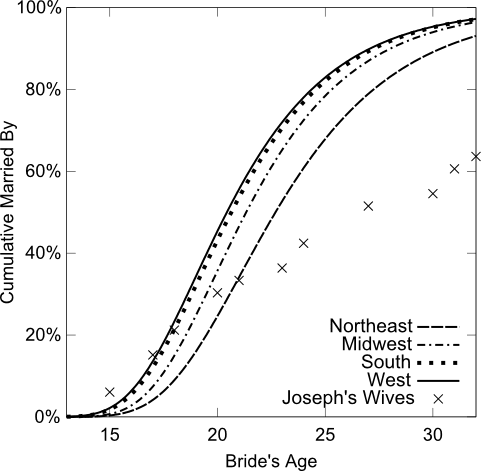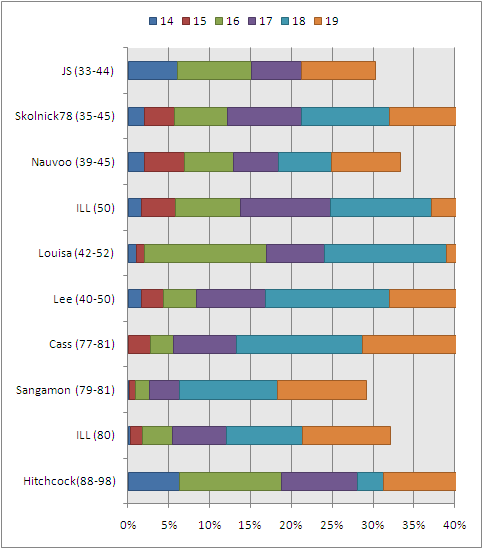Signature Books has recently issued a press release about an article that I co-authored along with Craig Foster and Gregory Smith. In the article we “strongly suggest[ed] that … the age of Joseph’s wives was well within the norm for their time and place on the nineteenth-century American frontier.” The public relations employees of Signature Books are certainly entitled to disagree like Todd Compton did in a contrasting essay in the same book, The Persistence of Polygamy. To be clear, I agree with my critics that it is entirely inappropriate, not to mention illegal [thanks Last Lemming SteveDensley for correction], in today’s society to marry a 14 year old young woman.
At least one of Signature’s criticisms may have a degree of merit, perhaps my plots and graphs are too hard for the average reader to understand. That is one of the downsides of using methods found in academic demographics journals to reconstruct marital statistics in 1840 Illinois. I think Signature writers may have been a bit hasty in drawing conclusions from the data, but their loyalty to George D. Smith (whose opinion is critiqued in our article) is commendable.
The plots and tables in our chapter were meant to place the age distribution of Joseph Smith’s wives in as large of a context as possible. The statistics on marriage vary greatly across US regions and across decades. The average reader should be able to tell that Joseph Smith’s teenage bride’s ages compare reasonably well with frontier area dynamics, with the exception of the percentage of 14 year olds. The same reader could also focus on the data from recent times or from Northeastern states and argue that those should figure more prominently in their judgments against Joseph Smith.
For me the fairest test I could put Joseph Smith to was to 1) recover as best I can, the frequency distribution of first time brides who married in Illinois in 1840 and 2) to follow a common statistical method for evaluating a hypothesis, in this case evaluating whether it would be normal to find two fourteen year old brides in a set of 33 wives selected at random using statistics from the first step. In my test I utilized a worst case scenario for Joseph Smith wives. Using George D. Smith’s 1994 enumeration of 43 plural wives including 9 teens and 1 14 year old would have led to an even more favorable comparison for Joseph Smith. The numbers in the press release would fall somewhere in between.
So how does Joseph Smith’s teenage brides stack up against their 1840 Illinois peers? With the exception of 14 year olds they actually trail the cumulative frequency distribution: 14 (6.1% to 1.9% ), 15 (6.1% to 6.7%), 16 (15.2% to 15.6%), 17 (21.2 to 27.4% ), 18 (21.2% to 40.3%), and 19 (30.3% to 52.6%). If you were to select 33 brides at random many different times at these rates and track the number of 14 year olds, Joseph Smith’s brides would rank between the 86th and 98th percentile. Either edge falls below common 2 tailed-thresholds for testing hypotheses (the 2 standard deviation rule or the 5% rule.) In other words, it turns out that Joseph’s profile is not significantly different than that of his ambient society, hence one can safely conclude it was normal.
Now I realize that some readers might not be able to follow that analysis. The bar chart below might help conceptualize the experiment described above. Although the sample sizes vary widely, Craig Foster randomly selected some counties, mostly from the Illinois-Iowa region. I charted those in comparison to my Illinois Census reconstruction, of marriage cohorts in 1850 and 1880, and against some Mormon marriage cohorts. For good measure we added a county more out on the frontier (Hitchcock, Nebraska) that had about the same sample size as Joseph’s set. Not surprisingly, it had a higher frequency of 14 year old brides than those married to Joseph Smith.
While the Signature press release does make a number of good points, readers can find a fuller contextualization and discussion of those points within the original article itself. The Signature reaction failed to engage my statistical definition of marital age normalcy at all. My co-authors and I spent considerable effort collecting and analyzing data and surveying the relevant literature, so I would plead with the historical community to give us a fair hearing. I will have considered it time well spent if individual Latter Day Saints ^Latter-day Saints [hat tip Ardis] take a position on the issue that falls somewhere in between Todd Compton’s and ours. While Compton disagrees with us on how normal the 14 year old plural brides were compared to their monogamous peers, he has a brilliant way of explaining what he regards as an abnormality (Helen Mar Kimball’s marriage). We also seem to be in agreement that extremist commentary on the subject has been a disservice to the public.
Continue reading at the original source →





